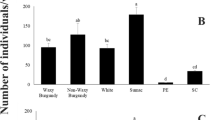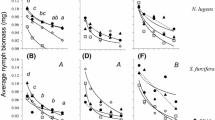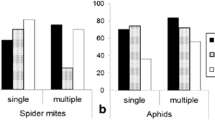Abstract
Intraspecific competition in the rice weevil, Sitophilus oryzae (L.) and the angoumois grain moth, Sitotroga cerealella (Oliv.) in grain sorghum was studied in laboratory experiments. Progeny production per female of each of the two species when reared separately, decreased as the initial parent population density increased. The number of progeny produced by Sitophilus oryzae increased to a peak, and then declined sharply with a further increase in initial parent population density, characteristic of a scramble competition. In contrast, the progeny produced by Sitotroga cerealella increased with an increase in parental density to reach a fairly constant maximum (flat topped curve), characteristic of a contest competition. It is concluded that intraspecific competition will not limit the potential of the grain moth S. cerealella of becoming a major pest of stored sorghum.
Résumé
La compétition intraspécifique au sein de populations du charançon du riz, Sitophilus oryzae (L.) et de l’alucite des céréales, Sitotroga cerealella (Oliv.) a été étudiée dans des conditions de laboratoire. En élévages separés, la prolificité par femelle de chaque espèce diminuait au fur et a mesuré que la densité de la population parentale initiale augmentait. Le nombre de progénitures de Sitophilus oryzae augmentait jusqu’à un pic, pour ensuite chuter abruptement suite a l’augmentation de la population parentale, un fait caractéristique a une compétition ascendante. Par contre, le nombre de progénitures chez Sitotroga cerealella croissait en même temps que l’augmentation de la densité de la population parentale mais pour atteindre un maximum constant (courbe à un sommet aplani), caractéristique devolue à une compétition concurrente. On a donc conclu que la compétition intraspecifique ne pourra pas limiter la potentialité de S. cerealella, d’infliger des dégâts importants au sorgho emmagasiné.
Similar content being viewed by others
References
Agha A. A. (1961) The biology of Sitotroga cerealella with special reference to food and the effect of extreme physical conditions. PhD Thesis, University of London.
Bellows Jr. T. S. (1982) Analytical model for laboratory populations of Callosobruchus chinensis and C. maculatus (Coleoptera, Bruchidae). J. tAnim. Ecol. 51, 263–287.
Birch L. C. (1945) The influence of temperature, humidity and density on the oviposition of the small strain of Calandra pryzae (L.) and Rhyzopertha dominica (Fab.) (Coleoptera). Aust. J. Exp. Biol. Med. Sci. 23, 197–203.
Crombie A. C. (1944) On intraspecific and interspecific competition in larvae of graminivorous insects. J. texp. Biol. 20, 135–151.
De Lima C. P. F. (1978) A study of the bionomics and control of Sitophilus zeamais (Motchulsky) and Sitotroga cerealella (Oliver) and associated fauna in stored maize under laboratory and field conditions in Kenya. PhD Thesis, Univeristy of London.
Elton C. (1946) Competition and the structure of ecological communities. J. Anim. Ecol 15, 54–63.
Giga D. P. and Smith R. H. (1991) Intraspecific competition in the bean weevils Callosobruchus maculatus and Callosobruchus rhodesianus (Coleoptera: Bruchidae). J. Appl. Ecol 28, 918–929.
Hasseil M. P. (1976) The dynamics of competition and predation. Studies in Biology No. 72. Edward Arnold Publishers.
Husted S. R. and Mills R. B. (1969) Intraspecific Kernelentry behaviour and competition among larvae of the angoumois grain moth. Transaction Kansas Acad. Sci. 72, 252–258.
Maclagan D. S. (1932) The effect of population density upon rate of reproduction with special reference to insects. Proc. R. Soc. Lond. IIIB, 437–454.
Markham R. H. (1981) The ecology of insect pest population in maize storage cribs in Nigeria. PhD Thesis, University of London.
Ricker W. E. (1954) Effects of compensatory mortality upon population abundance. J. tWildlife Manage. 18, 45–51.
Sharifi S. and Mills R. B. (1971) Development activities and behaviour of the rice weevil inside wheat kernels. J. tEcon. Entomol. 64, 1114–1118.
Shazali M. E. H. (1982) The biology and population ecology of four insect pests of stored sorghum with particular reference to competition and succession. PhD Thesis, University of Reading.
Shazali M. E. H. (1993) Interspecific competition between larvae of Sitaphilus oryzae (L.) and Sitotroga cerealella (Oliv.) in sorghum grains. Insect Sci. Applic. 14, 285–288.
Smith R. H. and Lessells C. M. (1985) Opposition, ovicide and larval competition in graminivorous insects, pp. 423–448. In Behavioural Ecology: Ecological Consequences of Adaptive Behaviour (Edited by R. M. Silby and R. H. Smith). Blackwell Scientific Publications, Oxford.
Solomon M. E. (1953) The population dynamics of storage pests. IX int. Congr. Ent Amsterdam 2, 235–248.
Varley G. C., Gradwell G. R. and Hassell M. P. (1973) Insect Population Ecology. Blackwell Scientific Publications, Oxford.
Author information
Authors and Affiliations
Rights and permissions
About this article
Cite this article
Shazali, M.E.H. Intraspecific Competition in Sitophilus Oryzae (L.) and Sitotroga Cerealella (Oliv.) In Grain Sorghum. Int J Trop Insect Sci 17, 357–361 (1997). https://doi.org/10.1017/S1742758400019184
Accepted:
Published:
Issue Date:
DOI: https://doi.org/10.1017/S1742758400019184
Key Words
- intraspecific competition
- rice weevil
- angoumois grain moth
- Sitophilus oryzae
- Sitotroga cerealella
- contest
- scramble
- sorghum




